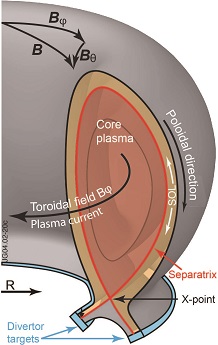The influence of magnetic geometry on the plasma edge region of future fusion reactors
This project is to study the influence of magnetic geometry on the plasma edge region of future fusion reactors, using a combination of experiments on TCV (Switzerland) and MAST-Upgrade (UK), and simulations using SOLPS, BOUT++ and other models. This is a collaboration between the University of York, Durham University, CCFE (UK) and EPFL (Switzerland), funded by the EPSRC under grant EP/N023846/1. The Principal Investigators are Prof. Bruce Lipschultz at York and Prof. Ray Sharples at Durham, Co-Investigators Prof. Kieran Gibson and Dr Ben Dudson at York, and post-doctoral researchers Dr Xiande Feng (Durham), Dr Chris Bowman (York) and Dr Alex Fil (York).
Background
Plasmas in magnetic fields occur throughout nature and in the laboratory. The complex intersection between plasma, atomic physics and magnetic fields often produces highly non-linear and dynamic behaviour. This proposal focuses on studying how plasma cools as it interacts with impurities and the surrounding gas. Our goal is to understand how to optimise the design of fusion devices, where plasma must be cooled before it hits the walls of the machine.

In a tokamak fusion device heat from fusion reactions in the hot core plasma leaks across the separatrix into the adjacent Scrape-off Layer (SOL) region (see Figure). Heat and particles are then transported along the magnetic field to the ‘divertor targets’. Target surfaces must be designed to handle the exhaust power. While transport along magnetic field lines is fast, energy transport across field lines is slow (necessary for fusion energy production in the plasma core). This results in a narrow SOL heat flux channel, predicted for a reactor (Radius, R ~ 5m) to be as small as a mm, leading to heat fluxes far past technological limits. Arranging the target geometry leads to a significant reduction, but the heat flux remains too high. To further reduce the target heat flux we use impurities to cool the plasma to the point where plasma begins to recombine into gas before reaching the targets. The high pressure plasma ‘detaches’ from the target and moves upstream. This phenomenon in tokamak plasmas is called ‘detachment’ and has been the primary path to heat flux reduction at the target. Nevertheless, further reductions are needed for a viable reactor-scale device.
News
- May 2017: Dr Chris Bowman visiting IPP Greifswald to work on Bayesian frameworks for integrated diagnostics
- 4th May 2017: Dr Xiande Feng started work at Durham on spectroscopy diagnostics
- 1st October 2016: Grant started, with York PDRAs Chris Bowman and Alexander Fil.
- 8th August 2016: PDRA jobs advertised, one integrated data analysis here, and one in tokamak divertor modelling here.
- 30th June 2016 : Grant awarded. Scientists in the Department of Physics’ York Plasma Institute (YPI) have received a £1M grant from EPSRC to study power exhaust in hot magnetic fusion plasmas (10s of millions C).
Objectives
Our preliminary analysis of snowflake and super-x vs conventional divertor configurations demonstrate that these topologies introduce new physics that strongly improves both the control and the power exhaust capability of detachment in tokamaks. This will be confirmed both experimentally and using state-of-the-art computer models.
There are three main objectives:
- Compare the detachment threshold and window across the three divertor topologies to analytic and 1D model predictions.
- Develop & utilise enhanced 2D measurements of the detachment region structure, along with state of the art integrated analysis of multiple diagnostics, to (de)validate the physics in our 2D models regarding detachment physics across topologies. This is crucial to improving such models for application to ITER operation, DEMO design, as well as having potential applications to other low-temperature plasmas.
- Verify predictions of the enhanced control of the detachment front location, or size of the detached region, to external controls for the snowflake and super-x topologies. Perform detailed comparison of measured detachment dynamics and characteristics to 1D and 2D models.
Applications
Understanding particle and heat transport along magnetic field lines, where strong density and temperature gradients are present, has many applications. For example, ‘condensations’ are found in astrophysical and solar plasmas. Solar coronal loops of magnetic fields lead to prominences where condensations often form farthest from the heat source (chromosphere) and can produce ‘coronal rain’ - bright low Te regions, possibly low pressure, that move from the corona to the chromosphere.
Plasma thrusters, utilizing flux expansion, are employed for spacecraft propulsion; the magnetic geometry, together with plasma gradients that are formed, play a key role in generating thrust. While we expect all of these applications, and more, to benefit from the research here, we choose to focus on one particular application, which best exploits the expertise of the research team - the physics of heat and particle exhaust from a tokamak fusion reactor.

